Method of Stamping the Progression of a Beverage End Rivet of a Thinner Sheet of AW-5182 Alloy
Abstract
:1. Introduction
2. Materials and Experiment
2.1. Material
2.2. Shaping the Beverage End Rivet Progression
- R1–the radius between the end and the side of the shaped rivet;
- R2–the radius between the side of the shaped rivet and the top surface;
- R3–the radius between the sides of the shaped body with a hexagonal base.
2.3. Testing Methods
- − light beam test;
- − micro-leakage test (pressure).
3. Results
4. Conclusions
- Simulations performed for different shapes of stamping dies indicate that one of the most important factors of the stamping process is the geometry of the tools that form the stamping with the expected final thickness and thinning of the sheet.
- The transition radii between the different surfaces, i.e., the shape of the stamping tools, should ensure the free flow of the stamped material. The use of sharp-edged tools promotes breakage of the continuity of the stamped material.
- Stamping tools of a closed shape, such as the rivet of a beverage end, require venting to evacuate air to limit the deformation of the stamping during forming.
- The introduction of four additional stamping operations for the sheet metal in the rivet-forming progression created the conditions for obtaining a properly shaped component, as expected. The thinning of a 0.200 mm sheet is less than for a 0.208 mm sheet stamped with three stamping operations.
- As computer simulations have shown, the designed tools can also be used successfully to shape the rivet progression for the sheet metal currently in use. No retooling of the presses will be required when changing sheet thicknesses.
- A concept has been developed to form the progression of the rivet of a beverage end from the 0.200 mm thick sheet alloy AW-5182-H-48.
- An important element of the stamping process is the reproducibility of the mechanical properties of the material, which is difficult due to the production process realized by different suppliers.
- The development of a suitable technology for the production of the beverage end rivet creates the conditions for the use of thinner sheets, and thus better use of the material with the increasing demand for it.
Author Contributions
Funding
Institutional Review Board Statement
Informed Consent Statement
Data Availability Statement
Conflicts of Interest
References
- Kossakowski, P.; Wciślik, W.; Baklarz, M. Wybrane Aspekty Zastosowania Stopów Aluminium W Konstrukcjach Budowlanych. Struct. Environ. 2017, 9, 256–263. [Google Scholar]
- Singh, R.P.; Kumar, S.; Pande, S.; Salunkhe, S.; Ragab, A.E.; Singh, P.K.; Meraz, M.; Davim, J.P. Robot-Assisted Cold and Warm Incremental Sheet Forming of Aluminum Alloy 6061: A Comparative Study. Metals 2023, 13, 568. [Google Scholar] [CrossRef]
- Schneider, R.; Heine, B.; Grant, R.J.; Zouaoui, Z. Aluminium Sheet Metal Forming at Low Temperatures. IOP Conf. Ser. Mater. Sci. Eng. 2015, 74, 012014. [Google Scholar] [CrossRef]
- Tisza, M.; Budai, D.; Kovács, P.Z.; Lukács, Z. Investigation of the Formability of Aluminium Alloys at Elevated Temperatures. IOP Conf. Ser. Mater. Sci. Eng. 2016, 159, 012012. [Google Scholar] [CrossRef]
- Jurczak, W. Problemy i Perspektywy Stopów Aluminium w Zastosowaniu Na Konstrukcje Morskie. Zeszyty Nauk. Akad. Mar. Wojennej 2019, 52, 89–106. [Google Scholar]
- Lestido-Cardama, A.; Sendon, R.; Bustos, J.; Nieto, M.T.; Losada, P.P.; Rodriguez-Bernaldo de Quiros, A. Food and beverage can coatings: A review on chemical analysis, migration, and risk assessment. Compr. Rev. Food Sci. Food Saf. 2022, 21, 3558–3611. [Google Scholar] [CrossRef] [PubMed]
- Wiśniewska, J.; Konieczny, J.; Giza, E.; Koczuba, J.; Kotarska, A. Produkcja Puszek Aluminiowych Do Napojów Gazowanych. PSKN Instytut Mater. Inżynierskich i Biomed. Politech. Śląskiej W Gliwicach 2015, 39, 21–30. [Google Scholar]
- Marks, N. Ocena Procesu Rozlewu Piwa Do Puszek W Browarze. Inżynieria Rol. 2008, 5, 111–117. [Google Scholar]
- Ubertalli, G.; Matteis, P.; Ferraris, S.; Marcianò, C.; D’aiuto, F.; Tedesco, M.M.; De Caro, D. High Strain Rate Behavior of Aluminum Alloy for Sheet Metal Forming Processes. Metals 2020, 10, 242. [Google Scholar] [CrossRef]
- Kuczek, Ł.; Muzykiewicz, W.; Mroczkowski, M.; Wieczorek, M. Propozycja Modyfikacji Metody Miseczkowania AEG Oceny Tłoczności Blach. Nauk.-Tech.-Technol 2021, 2, 77–92. [Google Scholar] [CrossRef]
- Schuster, P.; Österreicher, J.; Kirov, G.; Sommitsch, C.; Kessler, O.; Mukeli, E. Characterisation and Comparison of Process Chains for Producing Automotive Structural Parts from 7xxx Aluminium Sheets. Metals 2019, 9, 305. [Google Scholar] [CrossRef]
- Chien-Wei, L.; Fuh-Kuo, C. Formability study on stamping an engine hood with aluminum alloy sheet. IOP Conf. Ser. Mater. Sci. Eng. 2019, 651, 012103. [Google Scholar] [CrossRef]
- Piekło, J.; Burbelko, A.; Garbacz-Klempka, A. Shape-Dependent Strength of Al Si9Cu3FeZn Die-Cast Alloy in Impact Zone of Conformal Cooling Core. Materials 2022, 15, 5133. [Google Scholar] [CrossRef] [PubMed]
- Barnes, A.J.; Raman, H.; Lowerson, A.; Edwards, D. Recent Application of Superformed 5083 Aluminum Alloy in the Aerospace. Industry. Mater. Sci. Forum 2012, 735, 361–371. [Google Scholar] [CrossRef]
- Dursun, T.; Soutis, C. Recent developments in advanced aircraft aluminium alloys. Mater. Des. 2014, 56, 862–871. [Google Scholar] [CrossRef]
- Hosford, W.F.; Duncan, J.L. The aluminum beverage can. Sci. Am. 1994, 271, 48–53. [Google Scholar] [CrossRef]
- Wędrychowicz, P.; Kustra, P.; Paćko, M.; Milenin, A. A Flow Stress Model of the AA3104-H19 Alloy for the FEM Simulation of the Beverage Can Manufacturing Process under Large Plastic Deformations. Materials 2021, 14, 6408. [Google Scholar] [CrossRef]
- LaKind, J.S. Can coatings for foods and beverages: Issues and options. Int. J. Technol. Policy Manag. 2013, 13, 80–95. [Google Scholar] [CrossRef]
- Oldring, P.K.T.; Nehring, U. Metal packaging for foodstuffs. In Packaging Materials; ILSI (International Life Sciences Institute): Brussels, Belgium, 2007; pp. 1–40. [Google Scholar]
- Ellis, R.F.; Jackson, J.M.; Shinn, B.M. Rigid metal containers. In Fundamentals of Food Canning Technology; AVI Publishing Company: Westport, CT, USA, 1979; pp. 95–122. [Google Scholar]
- Morrison, J. Safety in Easy Open Ends. Can Mak. 1991, 4, 14. [Google Scholar]
- Walek, J.; Michalek, K.; Tkadlečková, M.; Saternus, M. Modelling of Technological Parameters of Aluminium Melt Refining in the Ladle by Blowing of Inert Gas through the Rotating Impeller. Metals 2021, 11, 284. [Google Scholar] [CrossRef]
- Guerrero-Vaca, G.; Carrizo-Tejero, D.; Rodriguez-Alabanda, O.; Romero, P.E.; Molero, E. Experimental Study for the Stripping of PTFE Coatings on Al-Mg Substrates Using Dry Abrasive Materials. Materials 2020, 13, 799. [Google Scholar] [CrossRef] [PubMed]
- Miłek, T. Ocena Tłoczności Blach Metodami Engelhardta i Erichsena. Sci. Lett. Rzesz. Univ. Technol.-Mech. 2018, 90, 195–204. [Google Scholar] [CrossRef]
- Adamus, J.; Dyja, K.; Więckowski, W. Influence of Frictional Conditions on Strain. Obróbka Plast. Met. 2014, 25, 277–286. [Google Scholar]
- Hyrcza-Michalska, M.; Kawalla, R.; Dembiñska, J. Drawability Studies of Magnesium Alloy Sheets at Elevated Temperature. Arch. Metall. Mater. 2015, 60, 2751–2756. [Google Scholar] [CrossRef]
- Yi, L.; Yu, G.; Tang, Z.; Li, X.; Gu, Z. Investigation of the Hot Stamping-in-Die Quenching Composite Forming Process of 5083 Aluminum Alloy Skin. Materials 2023, 16, 2742. [Google Scholar] [CrossRef]
- Pawlicki, M.; Rozmysłowicz, M.; Pieszak, M. Badania Walcowania Pakietowego Aluminium Oraz Tłoczenia Próbek z Materiału o Strukturze Ultra Drobnej. Obróbka Plast. Met. 2016, 27, 45–58. [Google Scholar]
- Żmudzki, A.; Śledzińska, A.; Pietrzyk, M.; Woźniak, H.; Plewiński, A.; Drenger, T. Kontrola Jakoci Produktów Głębokiego Tłoczenia Blach Za Pomoc Symulacji Komputerowych. Obróbka Plast. Met. 2005, 16, 50–62. [Google Scholar]
- Attar, E.A.; Li, N.; Foster, A. A New Design Guideline Development Strategy for Aluminium Alloy Corners Formed through Cold and Hot Stamping Processes. Mater. Des. 2021, 207, 1–25. [Google Scholar] [CrossRef]
- Bobade, S.S.; Badgujar, T.Y. A State of Art in a Sheet Metal Stamping Forming Technology—An Overview. Int. J. Adv. Res. Innov. Ideas Educ. 2017, 3, 3760–3770. [Google Scholar]
- Pawlicki, M.; Drenger, T. Analiza Porównawcza Wyników Symulacji Komputerowej Procesów Kształtowania Wyrobów Cienkościennych. Obróbka Plast. Met. 2011, 12, 57–74. [Google Scholar]
- Stadnicki, J.; Wróbel, I. Evaluation of the Influence of Material Model Parameters on Quality of Designed Drawpieces. Mechanik 2016, 89, 820–821. [Google Scholar] [CrossRef]
- Jin, C.K. Application of the Progressive Forming Method in Simulation and Experimental Study of Rectangular Fins in a Heat Exchanger. Metals 2020, 10, 395. [Google Scholar] [CrossRef]
- Salem, E.; Shin, J.; Nath, M.; Banu, M.; Taub, A.I. Investigation of Thickness Variation in Single Point Incremental Forming. Procedia Manuf. 2016, 5, 828–837. [Google Scholar] [CrossRef]
- Vrolijk, M.; Lorenz, D.; Porzner, H.; Holecek, M. Supporting lightweight design: Virtual modeling of hot stamping with tailored properties and warm and hot formed aluminium. Procedia Eng. 2017, 183, 336–342. [Google Scholar] [CrossRef]
- Trzepieciński, T.; Najm, S.M.; Oleksik, V.; Vasilca, D.; Paniti, I.; Szpunar, M. Recent Developments and Future Challenges in Incremental Sheet Forming of Aluminium and Aluminium Alloy Sheets. Metals 2022, 12, 124. [Google Scholar] [CrossRef]
- Kałduński, P. Komputerowe Modelowanie i Numeryczna Analiza Wysokich Wytłoczek Kształtowanych Przetłaczaniem. Autobusy Tech. Eksploat. Syst. Transp. 2013, 14, 143–147. [Google Scholar]
- Ebenberger, P.; Uggowitzer, P.J.; Gerold, B.; Pogatscher, S. Efect of Compositional and Processing Variations in New 5182-Type AlMgMn Alloys on Mechanical Properties and Deformation Surface Quality. Materials 2019, 12, 1645. [Google Scholar] [CrossRef]
- Folle, L.F.; Silveira Netto, E.S.; Schaeffer, L. Analysis of the manufacturing process of beverage cans. J. Process. Technol. 2008, 205, 347–352. [Google Scholar] [CrossRef]
- EN 573-1; Aluminium and Aluminium Alloys—Chemical Composition and Form of Wrought Products—Part 1: Numerical Designation System. European Standard: Pilsen, Czech Republic, 2004.
- EN 485-2; Aluminium and Aluminium Alloys—Sheet, Strip and Plate—Part 2: Mechanical Properties (Includes Amendment A1:2018). European Standard: Pilsen, Czech Republic, 2018.

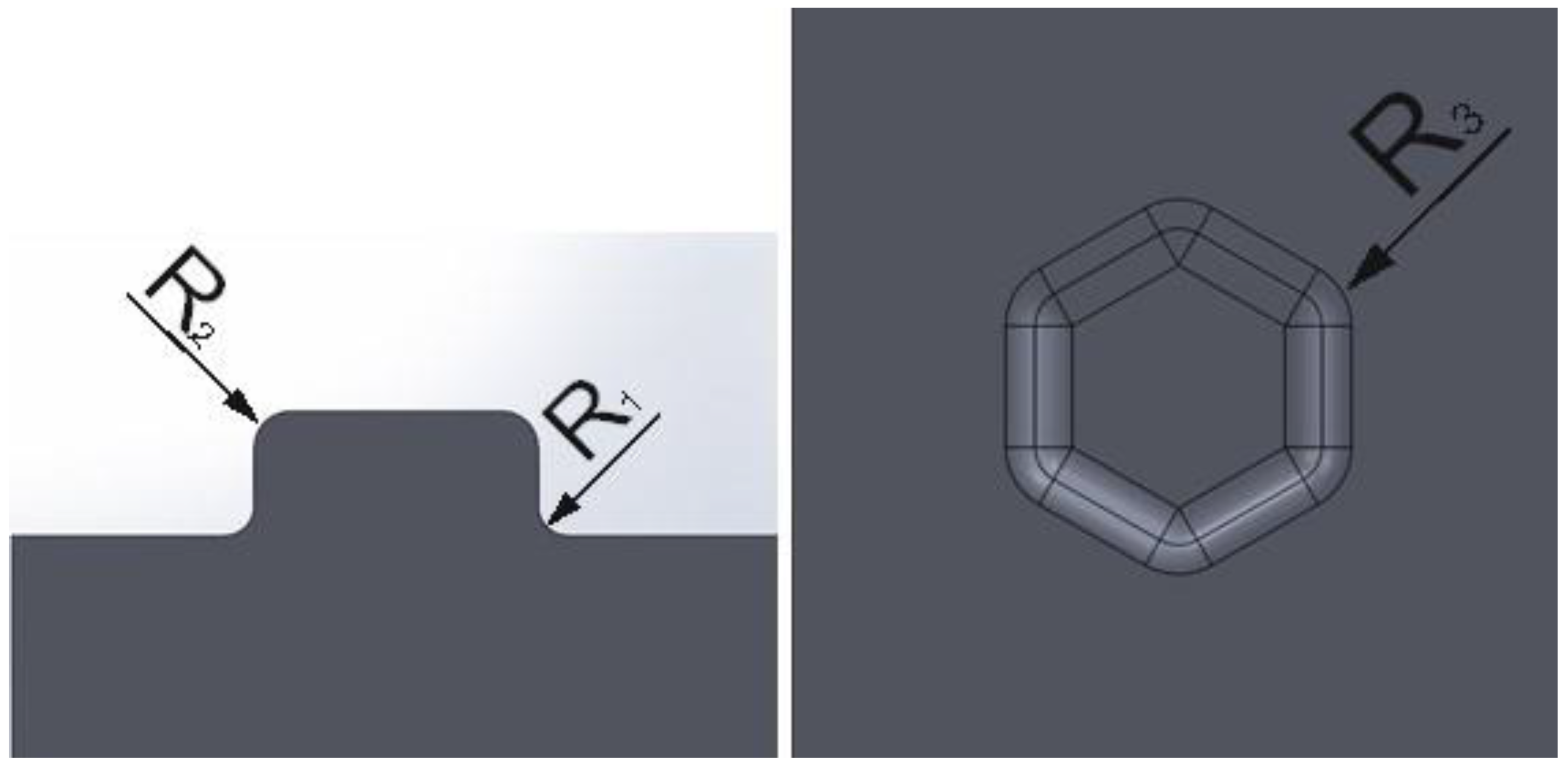
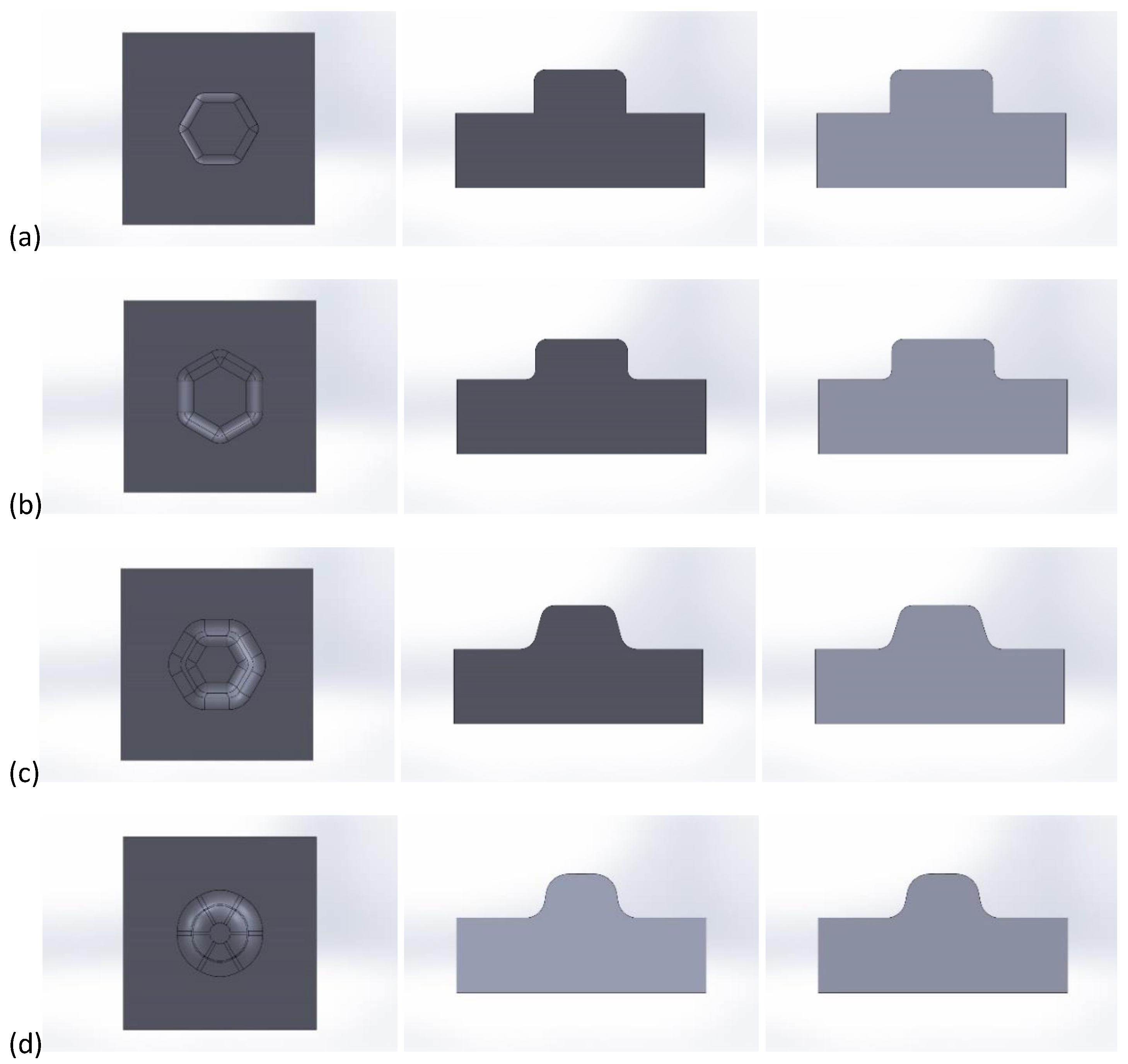
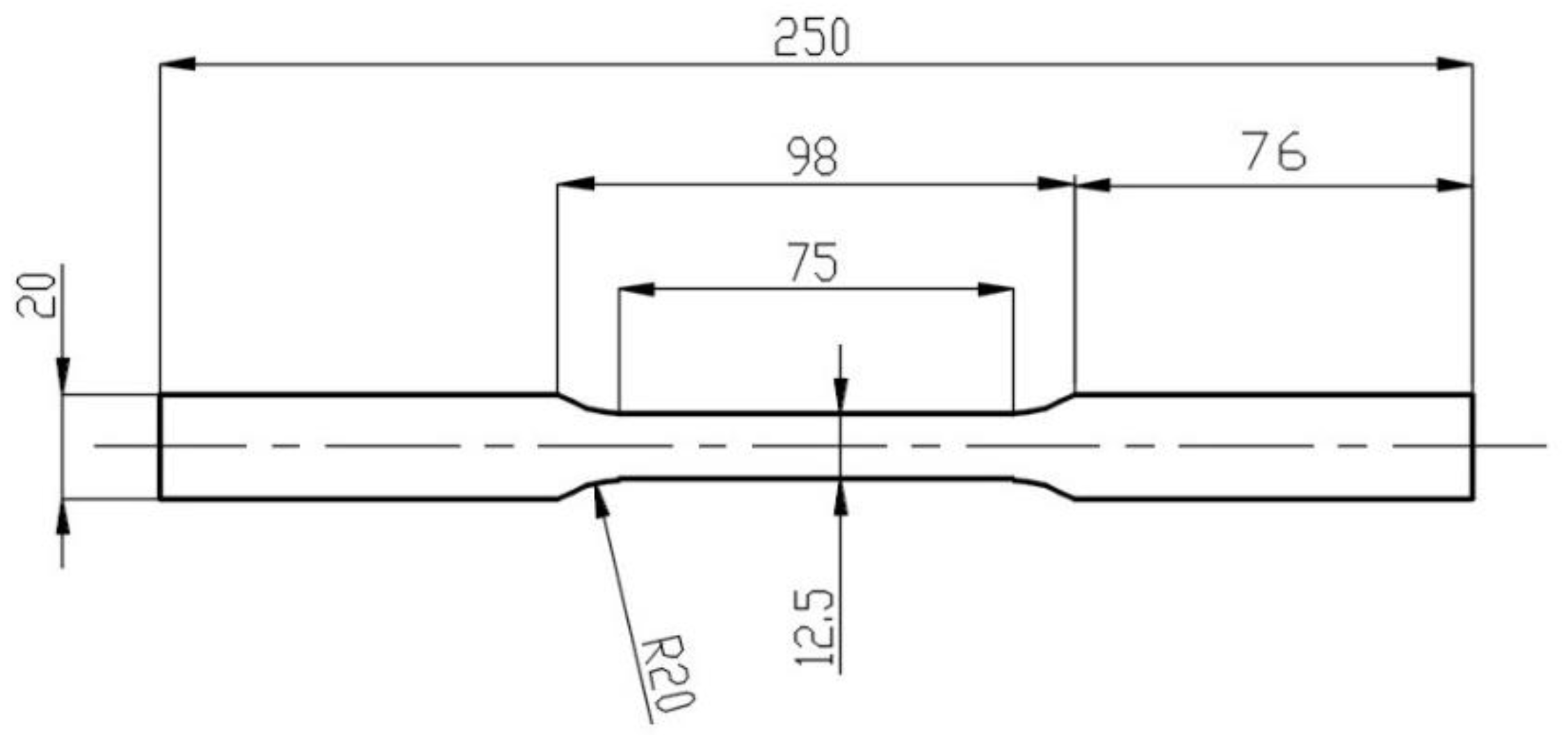




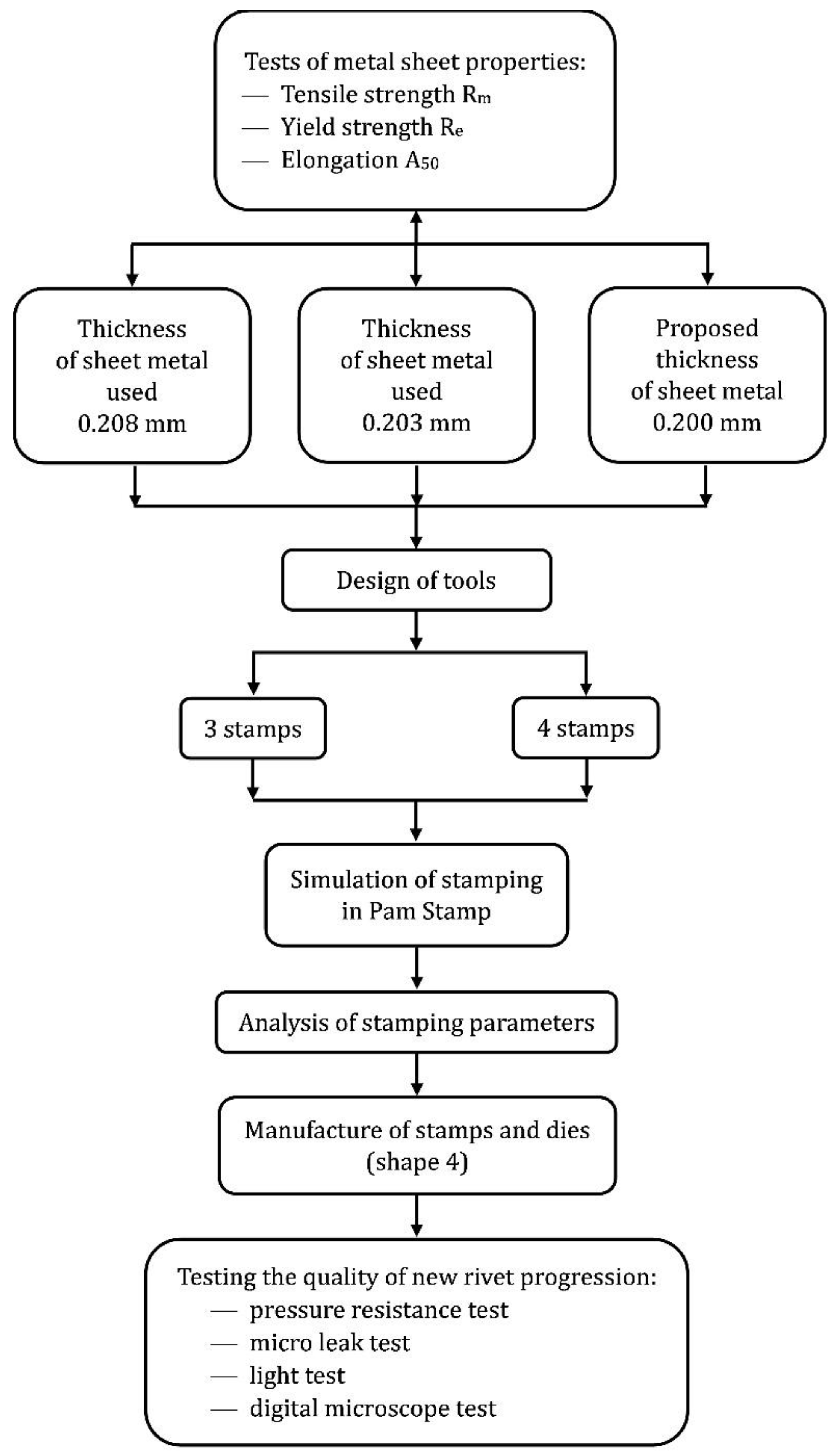
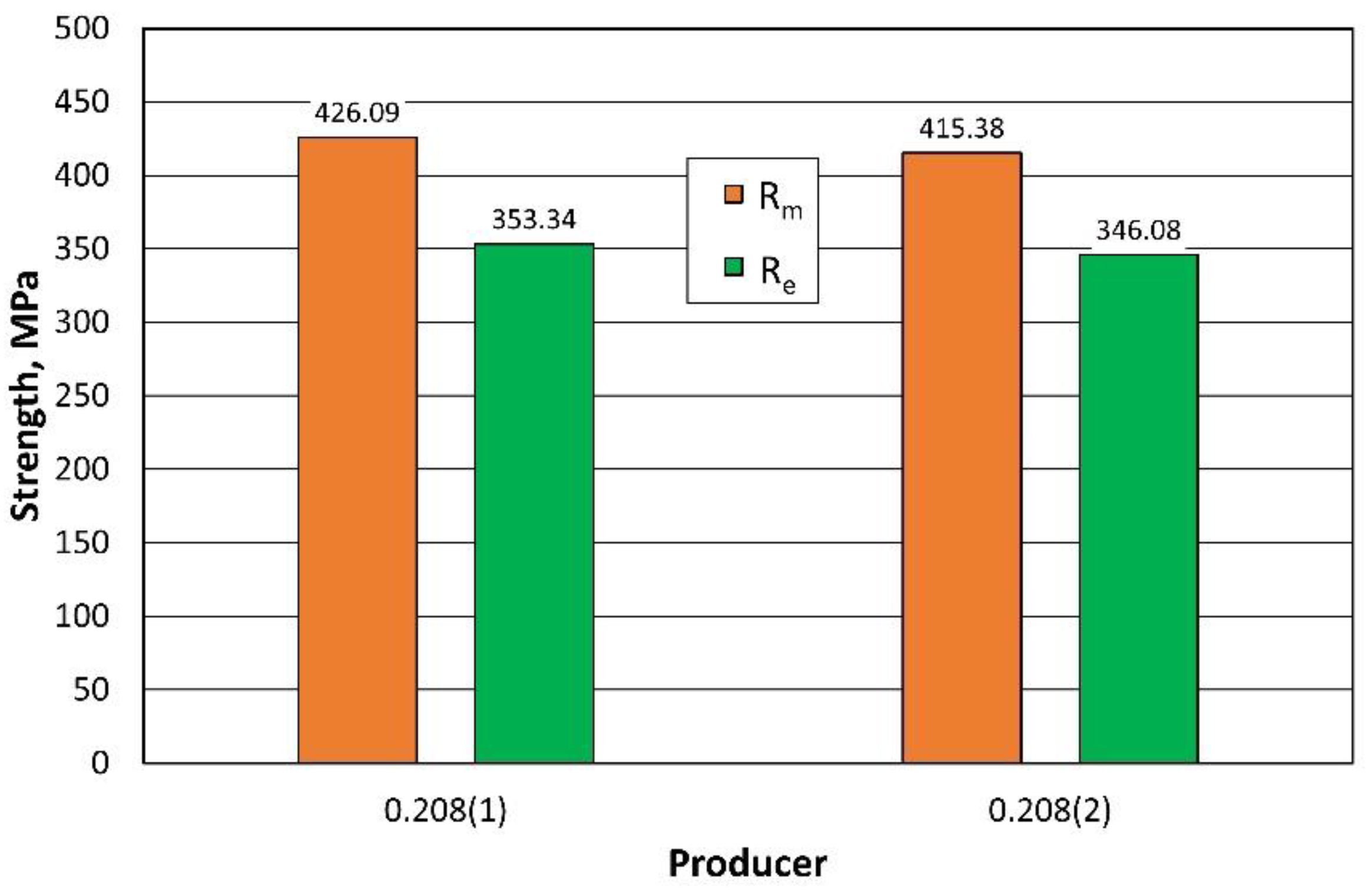


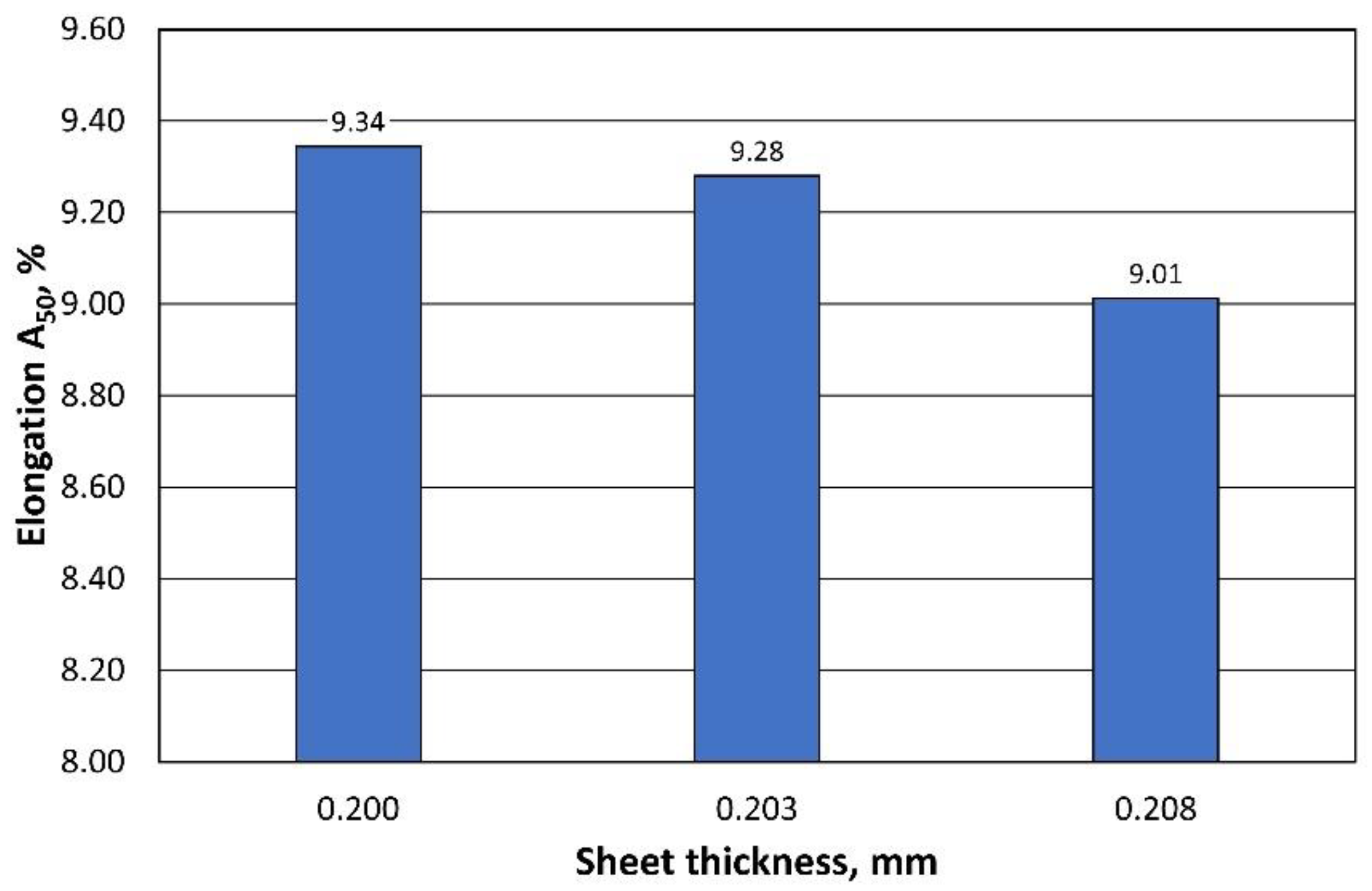









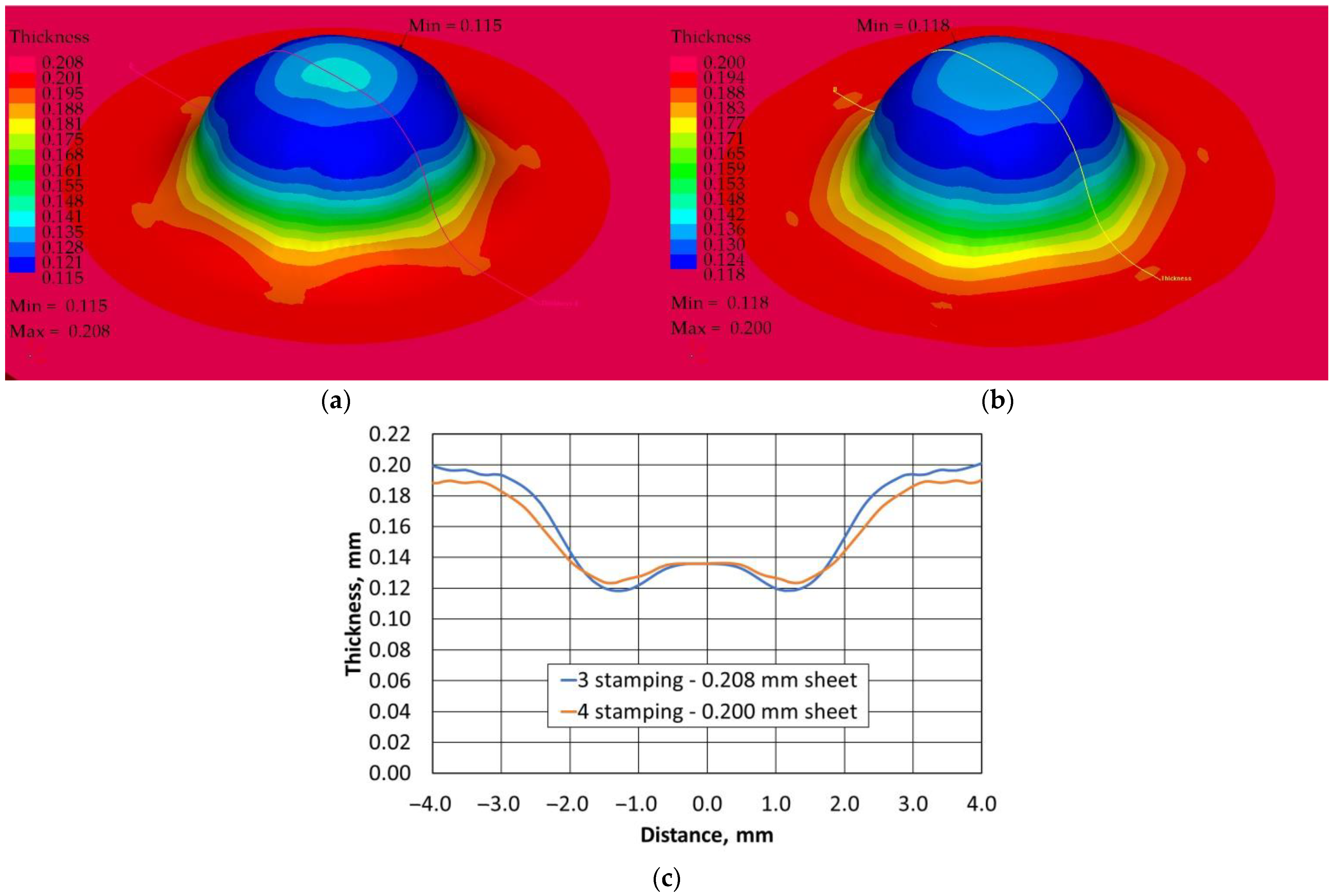

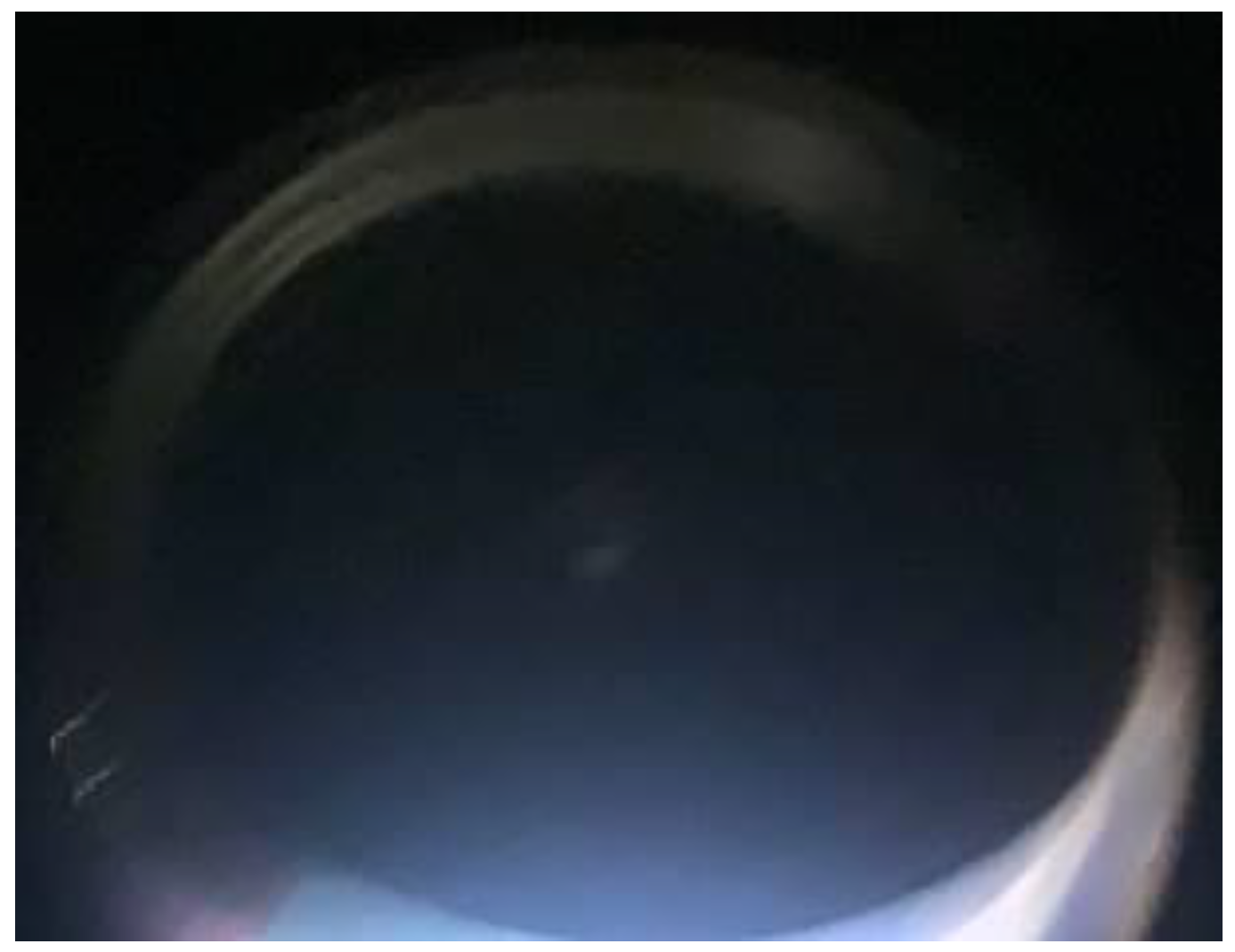

| Mg [%] | Mn [%] | Fe [%] | Si [%] | Cu [%] | Zn [%] | Cr [%] | Ti [%] | Other Each [%] | Other All [%] | Al [%] |
|---|---|---|---|---|---|---|---|---|---|---|
| 4.00–5.00 | 0.20–0.50 | ≤0.35 | ≤0.20 | ≤0.15 | ≤0.25 | ≤0.10 | ≤0.10 | ≤0.05 | ≤0.15 | rest |
| Density [g/cm3] | 2.7 |
| Modulus of elasticity E [MPa] | 71,000 |
| Longitudinal elastic modulus G [MPa] | 26700 |
| Poisson’s ratio | 0.33 |
| Solidification temperature [°C] | 585 |
| Pour point [°C] | 640 |
| Specific heat in 20 °C [J/kg∙K] | 902 |
| Thermal coefficient of expansion in 20 °C [μm/m∙K] | 24 |
| Tensile strength Rm [MPa] | 370–430 |
| Yield strength Re [MPa] | 330–390 |
| Elongation A50 min [%] | 4 |
| Parameters | Fmax [N] | Rm [MPa] | Re [MPa] | A50 [%] |
|---|---|---|---|---|
| Max | 1119.20 | 430.40 | 360.00 | 9.70 |
| Min | 1098.70 | 422.60 | 348.40 | 8.10 |
| Average | 1107.82 | 426.09 | 353.34 | 9.01 |
| Standard Deviation σ | 4.77 | 1.83 | 3.01 | 0.39 |
| Parameters | Fmax [N] | Rm [MPa] | Re [MPa] | A50 [%] |
|---|---|---|---|---|
| Max | 1089.30 | 419.00 | 355.40 | 11.10 |
| Min | 1072.40 | 412.50 | 335.00 | 7.90 |
| Average | 1079.93 | 415.38 | 346.08 | 9.29 |
| Standard Deviation σ | 4.68 | 1.79 | 6.20 | 0.79 |
| Parameters | Fmax [N] | Rm [MPa] | Re [MPa] | A50 [%] |
|---|---|---|---|---|
| Max | 1071.80 | 428.70 | 355.20 | 10.80 |
| Min | 1056.20 | 422.50 | 338.70 | 8.10 |
| Average | 1064.04 | 425.61 | 349.16 | 9.28 |
| Standard Deviation σ | 4.68 | 1.88 | 3.67 | 0.67 |
| Parameters | Fmax [N] | Rm [MPa] | Re [MPa] | A50 [%] |
|---|---|---|---|---|
| Max | 1074.80 | 423.60 | 355.70 | 10.60 |
| Min | 1053.10 | 415.00 | 337.80 | 7.80 |
| Average | 1063.87 | 419.12 | 345.08 | 9.34 |
| Standard Deviation σ | 5.15 | 2.09 | 3.84 | 0.64 |
| Thickness [mm] | Shape | Shape 1 | Shape 2 | Shape 3 | Shape 4 | ||||
|---|---|---|---|---|---|---|---|---|---|
| Parameters | Thkmin [mm] | Thnmax [%] | Thkmin [mm] | Thnmax [%] | Thkmin [mm] | Thnmax [%] | Thkmin [mm] | Thnmax [%] | |
| 0.208 | 3 punches | 0.020 | 90.4 | 0.033 | 84.3 | 0.086 | 58.7 | 0.115 | 44.8 |
| 4 punches | 0.030 | 85.8 | 0.029 | 85.9 | 0.102 | 50.8 | 0.124 | 40.2 | |
| 0.203 | 3 punches | 0.019 | 90.7 | 0.033 | 83.8 | 0.084 | 58.8 | 0.112 | 44.9 |
| 4 punches | 0.030 | 85.4 | 0.026 | 87.4 | 0.100 | 51.0 | 0.121 | 40.2 | |
| 0.200 | 3 punches | 0.018 | 90.9 | 0.032 | 84.0 | 0.082 | 58.9 | 0.110 | 44.9 |
| 4 punches | 0.028 | 86.1 | 0.025 | 87.7 | 0.098 | 51.0 | 0.118 | 40.3 | |
Disclaimer/Publisher’s Note: The statements, opinions and data contained in all publications are solely those of the individual author(s) and contributor(s) and not of MDPI and/or the editor(s). MDPI and/or the editor(s) disclaim responsibility for any injury to people or property resulting from any ideas, methods, instructions or products referred to in the content. |
© 2023 by the authors. Licensee MDPI, Basel, Switzerland. This article is an open access article distributed under the terms and conditions of the Creative Commons Attribution (CC BY) license (https://creativecommons.org/licenses/by/4.0/).
Share and Cite
Łucarz, M.; Jędrychowski, M. Method of Stamping the Progression of a Beverage End Rivet of a Thinner Sheet of AW-5182 Alloy. Materials 2023, 16, 6244. https://doi.org/10.3390/ma16186244
Łucarz M, Jędrychowski M. Method of Stamping the Progression of a Beverage End Rivet of a Thinner Sheet of AW-5182 Alloy. Materials. 2023; 16(18):6244. https://doi.org/10.3390/ma16186244
Chicago/Turabian StyleŁucarz, Mariusz, and Michał Jędrychowski. 2023. "Method of Stamping the Progression of a Beverage End Rivet of a Thinner Sheet of AW-5182 Alloy" Materials 16, no. 18: 6244. https://doi.org/10.3390/ma16186244
APA StyleŁucarz, M., & Jędrychowski, M. (2023). Method of Stamping the Progression of a Beverage End Rivet of a Thinner Sheet of AW-5182 Alloy. Materials, 16(18), 6244. https://doi.org/10.3390/ma16186244






